
Gila River Relocation Center, Arizona
(click to enlarge photo)
 A map of the layout of the camp. |
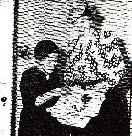 Eleanor Roosevelt visiting the camp. |
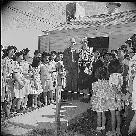 Mrs. Eleanor Roosevelt, accompanied by Dillon Myer, National Director of the War Relocation Authority, visit the Gila River Relocation Center, where they were greeted by crowds of enthusiastic evacuees. |
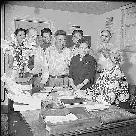 Representatives of councils greet Mrs. [Eleanor] Roosevelt. |
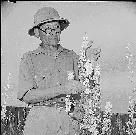 Itaro Nakata, former operator of an experimental nursery in Tracy, California, is shown with some choice specimens of larkspurs grown at the nursery here. Itaro has had 20 years experience in the nursery business and has developed and patented many new types of chrysanthemums. |
 Part of the farming work involved experimentation. |
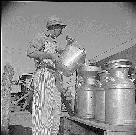 S. Ishimoto, former resident of El Centro, California, is shown at the dairy farm school, here. He will be the milk barn foreman as soon as it has been completed, but now is helping to train evacuee students. At El Centro, he owned and operated a 200 cow dairy. |
 Group picture of a class with the instructor at the blackboard, giving a lecture on dehydration. |
 Where ship models were built for the U.S. military. |
 Wataru Ichinotsubo, former produce market employee form Los Angeles, California, is shown sandpapering the hull of a model into final shape in the model ship factory here. These ships are carefully constructed for the Navy by the Japanese-American craftsmen. |
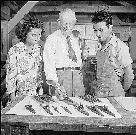 A collection of ship models made for the Navy in the model ship factory at the Gila Relocation Center. All of these models are replicas of German warships and are used in the identification training program. Oscar Julius, plant manager explains ship characteristics to Mary Iwamura (left), and Errol Ishii, plant foreman. |
 Kindergarten and Nursery children having a grand time on the see-saw. |
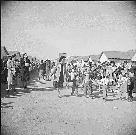 Evacuee participants who marched in the Harvest Festival Parade held at this center on Thanksgiving day |
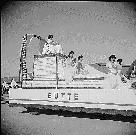 Pretty evacuee girls rode in this float in the Harvest Festival Parade which was held at this center on Thanksgiving day. |
 An evacuee of Japanese ancestry contemplates a move in the age-old game of "Go". |

Ration book being issued to the resettlers. On September 15, two weeks before the Canal Camp at Rivers, Arizona, was to close, only 635 people remained and 370 of these had bus or train reservations for the following week (the Canal Camp once had more than 5,000 residents). Most of the people are going out by special Greyhound buses. Their property, crated for freight shipment, is picked up at their homes and stored in project warehouses until it is loaded on the heavy trucking vans. Before the relocators leave the Center they get their special Relocation Grant from the Agent Cashier. Farm machinery, once used in the production of vegetables and melons for Gila and other centers, now is assembled ready to be moved from the Center. All the livestock is gone and buildings and fences are being torn down. |
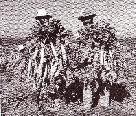 Growing daikon on the farms. |
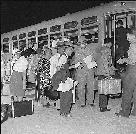 Evacuees returning to their former homes in California by Greyhound bus. On September 15, two weeks before the Canal Camp at Rivers, Arizona, was to close, only 635 people remained and 370 of these had bus or train reservations for the following week (the Canal Camp once had more than 5,000 residents). Most of the people are going out by special Greyhound buses. Their property, crated for freight shipment, is picked up at their homes and stored in project warehouses until it is loaded on the heavy trucking vans. Before the relocators leave the Center they secure their travel vouchers and their ration books from the Leave Office and get their special Relocation Grant from the Agent Cashier. Farm machinery, once used in the production of vegetables and melons for Gila and other centers, now is assembled ready to be moved from the Center. All the livestock is gone and buildings and fences are being torn down. |
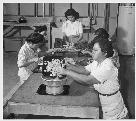 Students preparing carrots for dehydration. Carrots are peeled, sliced cross-wise, washed, and then steamed before the drying process is started. |
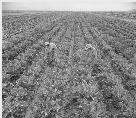 A view of cauliflower, which is being grown for its seed. Most cauliflower seed came from Denmark, but since the war that supply has been cut off. A very small amount is grown in California and Colorado, but has never been grown before in Arizona. Indications are that the experiment will be successful. Last year cauliflower seed sold for $45 per pound, and it is expected to sell for $70 or $75 per pound this year. 4/24/43 |
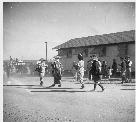 Participants of Japanese ancestry who participated in the Harvest Festival Parade held at this center on Thanksgiving day. 11/26/42 |
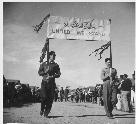 Two of the evacuees carrying the J.A.C.L. banner in the Harvest Festival Parade held at this center on Thanksgiving day. |
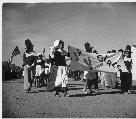 A group of V...- girls who participated in the Harvest Festival Parade at the Gila River Center on Thanksgiving day. 11/26/42 |
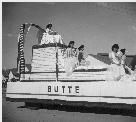 Pretty evacuee girls rode in this float in the Harvest Festival Parade which was held at this center on Thanksgiving day. 11/26/42 |
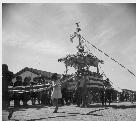 A float in the Harvest Festival Parade held at this center on Thanksgiving. . 11/26/42 |
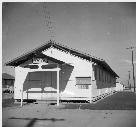 The Buddhist Church at camp two at this relocation center. |
 A line of evacuees waiting for lunch at one of the mess halls |
 Sunrise services (Christian) which were held at this center Thanksgiving day. 11/26/42 |
 Sgt . Kazuo Komoto, veteran of Guadalcanal and New Georgia, shows his medal, the Purple Heart, to his younger brother, Susumu, while visiting his parents at the Gila River Relocation Center near Phoenix, Arizona. 10/31/43 |
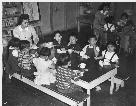 Butte Nursery and Kindergarten children's snack hour. 3/24/44 |
 Servicemen's Monument. 4/10/44 |
 Pvt. Joe Watanabe and his family. Pvt. Watanabe left with the first group of inductees for Camp Blanding, Florida. |
The Gila River tribe objected to the building of the relocation center. The maximum population of the camp was 13,348. The evacuees came from the Tulare, Turlock, Stockton and Fresno assembly centers and form Military Area 2. There were chronic water shortages. Although one watch tower was built it was torn down since there wasn't sufficient manpower to man it. Within six months the barbed wire fences were also torn down.
There was a camouflage net factory there but it ran only for five months, and there was also a model ship building shop for use in military training. There were two "sub-camps," the Butte River Camp and the canal Camp. Canal Camp was closed on Sept. 28, 1945 and Butte Camp on November 10, 1945. Buildings belonging to the Canal Camp site no longer stand but some of the foundations are still present. The same goes for Butte Camp. There are memorial landmarks, but since the land belongs to the Gila River Tribe permission must be obtained from them before visiting the site.
The government report "Riots, Strikes and Disturbances in Japanese Relocation Centers (1943), has this to say of the problems at Gila River:
"On December 17, 1942, an attack was made on (name blacked out). A knife was used in the attack...This attack was the result of differences which had arisen as a result of gambling."
In December, 1942, there was a fight over between two people over their clothing allowance. On Dec. 7, 1942, "...a Japanese flag was discovered flying on a butte overlooking part of the camp. ... On January 1, 1943, another homemade Japanese flag was discovered on another butte near the camp."
In February of 1943 representatives of the War Department went to the camp to conduct the registration of eligible Nisei. "On February 15, 1942, Army authorities reported that certain of the Japanese, both citizens and aliens, were interfering with the recruiting being conducted. These persons had allegedly threatened and intimidated those persons who had indicated a willingness to volunteer for military services."
From Final Report: Japanese Evacuation from the West Coast, 1942, dated June 5, 1943, about the area of the camp:"This Center is located in Pinal County, Arizona, near Sacaton on the Gila River Indian Reservation. There are approximately 16,100 acres of the reservation set aside for the use of the War Relocation Authority. The soil has an average depth of two feet of fine silt, over adobe and/or caliche. Irrigation produces bountiful crops of long staple cotton, alfalfa, vegetables, melons, etc. Water for irrigation is obtain from canals, originally developed by the Indian Services, and comes form the Gila River Reservoir."
 Syracuse Harold Journal, March 17, 1943 |
 Edwardsville Intelligencer, Sept. 22, 1943 |
Gila River newsletters
Although there have been many books written about the Japanese-American internment, only some of them even mention the newsletters produced at the camps and, at most, they generally will have only one or two pages from one of the issues.
This is leaving out one of the most historically interesting and important aspects of the internment. The newsletters that were produced give the day-to-day news of interest to the community of those who were interned. I am sure that there were restraints on what the newsletters were allowed to print, but they still tend to contain a wealth of interesting material.
I ran across one particularly valuable source, Densho. They have a vast number of the newsletters. I found a few elsewhere.
The Gila River material includes regular newsletters plus Co-op newsletters plus the Relocator newsletter. There are, as normal, some newsletters that are not present in the collection.
Volume 1, Issues 1-5
Volume 1, Issues 6-10
Volume 1, Issues 11-15
Volume 1, Issues 16-20
Volume 1, Issues 21-25
Volume 1, Issues 26-30
Volume 1, Issues 31-34
Volume 2, Issues 1-5
Volume 2, Issues 6-10
Volume 2, Issues 11-15
Volume 2, Issues 16-20
Volume 2, Issues 21-25
Volume 2, Issues 26-30
Volume 2, Issues 31-35
Volume 2, Issues 36-40
Volume 2, Issues 41-45
Volume 2, Issues 46-50
Volume 2, Issues 51-55
Volume 2, Issues 56-60
Volume 2, Issues 61-65
Volume 2, Issues 66-70
Volume 2, Issues 71-75
Volume 2, Issues 76-80
Volume 2, Issues 81-85
Volume 2, Issues 86-90
Volume 2, Issues 91-95
Volume 2, Issues 96-100 and 199
Volume 3, Issues 1-5
Volume 3, Issues 6-10
Volume 3, Issues 11-15
Volume 3, Issues 16-20
Volume 3, Issues 21-25
Volume 3, Issues 26-30
Volume 3, Issues 31-35
Volume 3, Issues 36-40
Volume 3, Issues 41-45
Volume 3, Issues 46-50
Volume 3, Issues 51-55
Volume 3, Issues 56-60
Volume 3, Issues 61-65
Volume 3, Issues 66-70
Volume 3, Issues 71-75
Volume 3, Issues 76-80
Volume 3, Issues 81-85
Volume 3, Issues 86-90
Volume 3, Issues 91-95
Volume 3, Issues 96-100
Volume 3, Issues 101-105
Volume 3, Issues 106-110
Volume 3, Issues 111-115
Volume 3, Issues 116-120
Volume 3, Issues 121-125
Volume 3, Issues 126-130
Volume 3, Issues 131-135
Volume 3, Issues 136-140
Volume 3, Issues 141-145
Volume 3, Issues 146-150
Volume 3, Issues 151-155
Volume 3, Issues 156-160
Volume 3, Issues 161-165
Volume 3, Issues 166-170
Volume 3, Issues 171-175
Volume 3, Issues 176-180
Volume 3, Issues 181-185
Volume 3, Issues 186-190
Volume 3, Issues 191-195
Volume 3, Issues 196-202
Volume 4, Issues 1-5
Volume 4, Issues 6-10
Volume 4, Issues 11-15
Volume 4, Issues 16-20
Volume 4, Issues 21-25
Volume 4, Issues 26-30
Volume 4, Issues 31-35
Volume 4, Issues 36-40
Volume 4, Issues 41-45
Volume 4, Issues 46-50
Volume 4, Issues 51-55
Volume 4, Issues 56-60
Volume 4, Issues 61-65
Volume 4, Issues 61-69
Gila Co-op News
Gila Bulletin
Relocator news week
Main Index
Japan main page
Japanese-American Internment Camps index page
Japan and World War II index page
| |